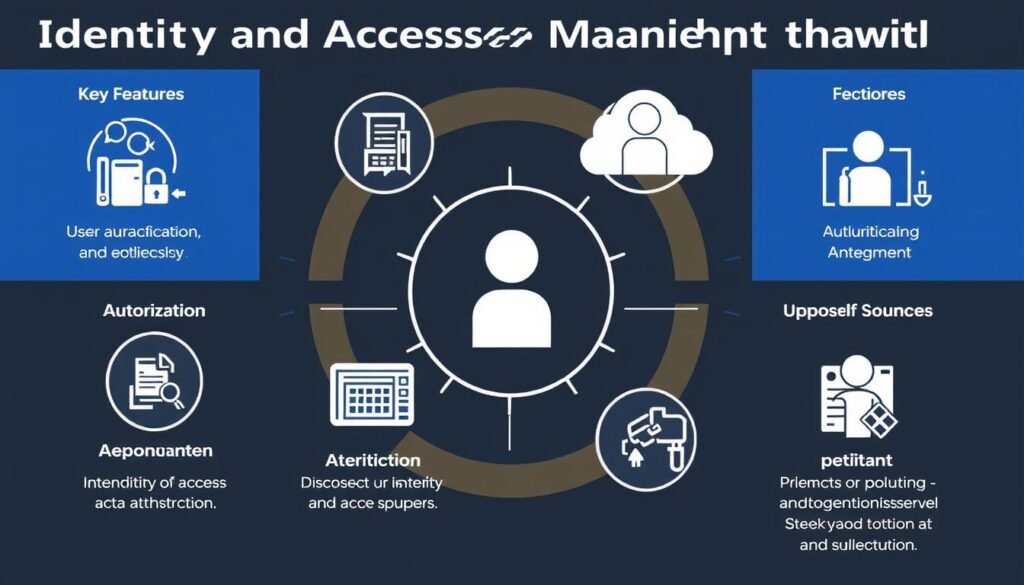In today’s digital landscape, a staggering 83% of organizations have experienced a data breach due to compromised credentials or insider threats. This alarming statistic underscores the need for a more robust security framework. Zero Trust Architecture emerges as a revolutionary approach, challenging traditional network security paradigms by mandating continuous identity verification for every user and device.
This paradigm shift is crucial as cyber threats become increasingly sophisticated. By adopting a Zero Trust model, organizations can significantly enhance their security posture, ensuring that sensitive information and critical infrastructure remain protected.
Key Takeaways
- Zero Trust Architecture represents a fundamental shift in network security approaches.
- Continuous verification is required for every user and device.
- This model offers a more resilient approach to protecting sensitive information.
- Adopting Zero Trust can significantly enhance an organization’s security.
- It’s becoming the new standard for network security across industries.
Understanding Zero Trust Security
Understanding Zero Trust Security is crucial for organizations looking to enhance their security posture in today’s complex digital landscape. As you delve into the world of Zero Trust, you’ll discover a security model that challenges traditional notions of trust within a network.
Definition and Evolution of Zero Trust
The term “Zero Trust” was coined by Forrester Research analyst John Kindervag, who introduced the concept of “never trust, always verify.” This approach is based on the assumption that risk is present both inside and outside the network. Zero Trust security represents a significant shift from traditional network security models that relied on a “trust but verify” approach.
The evolution of Zero Trust has been driven by the increasing sophistication of cyber threats and the adoption of cloud-based services. As organizations move towards digital transformation, the need for a more robust security model has become apparent.
The Shift from Traditional Perimeter-Based Security
Traditional perimeter-based security models trusted users and endpoints within an organization’s perimeter, making them vulnerable to insider threats and compromised credentials. Zero Trust assumes that threats exist both inside and outside organizational boundaries, requiring continuous verification and least privilege access.
The following table highlights the key differences between traditional perimeter-based security and Zero Trust security:
| Security Aspect | Traditional Perimeter-Based Security | Zero Trust Security |
|---|---|---|
| Trust Model | Trust but Verify | Never Trust, Always Verify |
| Access Control | Implicit trust within the perimeter | Least Privilege Access |
| Threat Assumption | Threats are external | Threats are both internal and external |
Core Principles of Zero Trust Architecture
To effectively implement Zero Trust, you must grasp its core principles, which are designed to provide robust security in a rapidly evolving threat landscape. The Zero Trust model, as outlined in the NIST 800-207 framework, revolves around three core principles that form the foundation of this security framework.
Never Trust, Always Verify
The “Never Trust, Always Verify” principle is the foundational tenet of Zero Trust. This principle requires that no entity — whether it is a user, device, or application — is trusted by default, regardless of whether it is inside or outside the network perimeter. Continuous authentication and authorization are essential for every user, device, and application attempting to access resources. This verification process applies regardless of location, creating a consistent security posture across all environments.
Principle of Least Privilege Access
The Principle of Least Privilege Access ensures that users and systems are granted only the minimum permissions necessary to perform their specific functions, significantly reducing the potential attack surface. This principle requires organizations to carefully define and manage access rights, regularly review permissions, and implement time-based or context-aware access controls to minimize security risks.
Assume Breach Mentality
The “Assume Breach Mentality” acknowledges that no security system is impenetrable and organizations must design their architecture with the assumption that breaches will occur. This mindset drives organizations to implement robust detection capabilities, segment networks to contain potential breaches, and develop comprehensive incident response plans.
Together, these three principles create a comprehensive security framework that addresses the limitations of traditional perimeter-based approaches and provides greater protection against modern cyber threats. Understanding and implementing these core principles is essential for organizations seeking to adopt Zero Trust Architecture effectively and enhance their overall security posture.
| Principle | Description | Benefits |
|---|---|---|
| Never Trust, Always Verify | Continuous authentication and authorization for all entities | Enhanced security, consistent security posture |
| Principle of Least Privilege Access | Granting minimum necessary permissions | Reduced attack surface, minimized security risks |
| Assume Breach Mentality | Designing for potential breaches | Robust detection, contained breaches, comprehensive incident response |
Why Traditional Security Models Fall Short
The limitations of traditional security approaches have become increasingly apparent in the face of modern cyber threats. Traditional cybersecurity models were based on creating a secure perimeter around an organization’s network or resources and trusting users and devices within that perimeter.
However, this approach has proven insufficient against modern cyber threats. The evolving threat landscape has grown significantly more sophisticated, with advanced persistent threats, ransomware, and supply chain attacks designed to circumvent perimeter defenses.
Limitations of Perimeter-Based Security
Traditional security models operated on the premise of establishing a secure perimeter around an organization’s network. This perimeter-based approach has become ineffective as organizational boundaries have blurred with the adoption of cloud services, mobile computing, and remote work arrangements.
- Implicitly trust users and devices within the network perimeter, failing to address insider threats or compromised credentials.
- Once attackers breach the perimeter, they can move laterally throughout the network with minimal resistance.
Evolving Threat Landscape
Modern attacks frequently target legitimate credentials through phishing and social engineering, rendering traditional authentication methods insufficient.
The increasing complexity of IT environments has created numerous potential entry points that traditional security models struggle to protect effectively.
| Threat Type | Characteristics | Impact |
|---|---|---|
| Advanced Persistent Threats (APTs) | Sophisticated, targeted attacks | Significant data breaches |
| Ransomware | Malicious encryption of data | Financial loss, data loss |
| Supply Chain Attacks | Targeting third-party vendors | Compromise of sensitive data |
How Zero Trust Architecture Works
Zero Trust Architecture revolutionizes network security by implementing a robust verification process for every user and device. This approach is fundamentally different from traditional security models, which often rely on a static perimeter.

Continuous Authentication and Authorization
At the heart of Zero Trust Architecture is the principle of continuous authentication and authorization. This means that users and devices are not just verified once at the initial access point, but are continuously monitored throughout their interaction with network resources.
The system evaluates multiple factors, including user credentials, device health, location, time of access, and behavioral patterns, to determine the risk level of each access request. This ongoing verification process ensures that access is granted based on the user’s identity, the security posture of their device, and the sensitivity of the data they are trying to access.
Dynamic Policy Enforcement
Dynamic policy enforcement is another critical component of Zero Trust Architecture. It enables organizations to adapt their security controls in real-time based on risk assessments. Access permissions are automatically adjusted according to changing conditions, such as the user’s location or the security posture of their device.
These policies consider various contextual information, including network connection type, resource sensitivity, and user behavior patterns, when making access decisions. By continuously monitoring and evaluating access requests against established policies, Zero Trust Architecture provides a more adaptive and resilient security framework capable of responding to evolving threats.
Essential Components of Zero Trust Implementation
The foundation of a robust Zero Trust framework lies in its key components, which work together to provide enhanced security and protect your organization’s resources.
Identity and Access Management
Identity and Access Management (IAM) serves as the backbone of Zero Trust, enabling you to authenticate users, manage their access rights, and enforce the principle of least privilege. Robust IAM systems allow for centralized identity verification and role-based access controls.

Multi-Factor Authentication
Multi-Factor Authentication (MFA) significantly enhances security by requiring users to provide multiple forms of verification before gaining access to resources. Risk-based MFA adapts authentication requirements based on contextual factors such as location, device, and behavior patterns.

Microsegmentation
Microsegmentation involves dividing your network into isolated security zones, limiting lateral movement and containing potential breaches. This approach ensures that even if attackers gain access to one segment, they cannot easily move to other segments, effectively minimizing the “blast radius” of any security incident.

By integrating these essential components—Identity and Access Management, Multi-Factor Authentication, and Microsegmentation—you can create a comprehensive Zero Trust framework that verifies every access request and provides robust security across your network and resources.
Zero Trust Network Access (ZTNA)
Zero Trust Network Access (ZTNA) is revolutionizing the way organizations manage secure access to their applications and data. As a crucial aspect of zero trust security, ZTNA focuses on managing application access by verifying that users and devices comply with organizational policies before every application session.
ZTNA vs. Traditional VPN
Unlike traditional VPNs that grant broad network access once a user is authenticated, ZTNA provides precise application-level access. This approach significantly reduces the attack surface by limiting users to only the specific resources they need and preventing lateral movement within the network.
ZTNA creates a logical access boundary around applications rather than networks, making the physical location of resources irrelevant to the security model. This results in a more seamless user experience compared to traditional VPNs, as connections are established directly to specific applications without requiring full network tunneling.
Application-Level Access Control
Application-level access control enables organizations to implement fine-grained policies based on user identity, device posture, and other contextual factors for each individual application. This granular control allows security teams to enforce different access requirements for applications based on their sensitivity and risk profile.
ZTNA continuously verifies trust throughout user sessions, not just at the initial connection, providing ongoing protection against credential theft and session hijacking. By integrating with existing identity providers and multi-factor authentication solutions, ZTNA creates a comprehensive security framework that protects applications regardless of where they’re hosted.
Implementing Zero Trust Security in Organizations
As organizations increasingly adopt digital technologies, implementing Zero Trust security becomes crucial. This approach requires a strategic, phased implementation that begins with thorough assessment and planning to ensure successful adoption across the organization.
Assessment and Planning Phase
The assessment phase involves identifying critical assets, mapping data flows, understanding existing security controls, and evaluating the current security posture against Zero Trust principles. You should prioritize protecting your most sensitive data and critical applications first, gradually expanding the Zero Trust model across the entire infrastructure.
- Identify all resources and their access points
- Map out potential risks and threats
- Understand existing security controls and their effectiveness
Deployment Strategies
Deployment strategies vary based on organizational size, industry, and existing infrastructure. A typical approach follows a crawl-walk-run methodology to minimize disruption to business operations. Many organizations begin by implementing identity and access management solutions, followed by device security controls, network segmentation, and finally data protection measures.
Monitoring and Continuous Improvement
Monitoring and continuous improvement are essential aspects of Zero Trust implementation. You need to collect and analyze security telemetry to identify gaps and refine policies. This ongoing process includes regular security assessments, threat hunting, user behavior analytics, and policy adjustments based on emerging threats and changing business requirements.
To measure the effectiveness of your Zero Trust implementation, establish clear metrics such as reduced attack surface, improved detection capabilities, and enhanced response times. Successful Zero Trust implementation is not a one-time project but a continuous journey that evolves with your organization’s security needs and the changing threat landscape.
NIST 800-207: The Zero Trust Framework Standard
NIST 800-207 is a pivotal publication that outlines the framework for Zero Trust Architecture, providing organizations with a standardized approach to enhance their security posture. The National Institute of Standards and Technology (NIST) provides guidelines for implementing Zero Trust Security in this publication, emphasizing the importance of continuous monitoring and risk assessment to detect and respond to threats in real-time.
Key Requirements and Guidelines
The NIST 800-207 standard outlines several key requirements for implementing Zero Trust Security. These include treating all data sources and computing services as resources, securing all communication regardless of network location, and granting access to individual resources on a per-session basis. Access to resources is determined by dynamic policies, ensuring that only authorized users and devices can access sensitive data and applications.
The framework also emphasizes the need for continuous monitoring and risk assessment to detect and respond to threats in real-time. This involves measuring and monitoring the security posture of all network resources and collecting data to improve access policies.
Compliance Considerations
Organizations must consider compliance requirements when implementing Zero Trust Security. The NIST 800-207 framework provides flexibility for organizations to maintain compliance with regulations such as GDPR, HIPAA, and PCI DSS. It is essential to document how Zero Trust implementation satisfies specific compliance requirements, particularly regarding data protection, access controls, and audit capabilities.
As emphasized in NIST 800-207, “All communication is secured, regardless of network location.” This principle is crucial in ensuring the security of sensitive data and applications. By following the guidelines outlined in NIST 800-207, organizations can ensure that their Zero Trust implementation is both effective and compliant with relevant regulations.
| Key Requirements | Description |
|---|---|
| Resource Protection | Treat all data sources and computing services as resources requiring protection. |
| Secure Communications | Secure all communication regardless of network location. |
| Access Control | Grant access to individual resources on a per-session basis, determined by dynamic policies. |

Benefits and Challenges of Zero Trust Architecture
As organizations consider adopting a zero trust model, it’s essential to understand the benefits and challenges that come with this approach. Zero trust architecture offers a robust security framework that can significantly enhance an organization’s security posture.
Enhanced Security Posture
One of the primary benefits of zero trust architecture is its ability to limit the exposure of sensitive data and reduce the risk of data breaches. By implementing continuous verification and least privilege access principles, organizations can minimize their attack surface.
Improved Visibility and Control
Zero trust architecture provides improved visibility and control over network resources, enabling security teams to monitor who is accessing what data, when, and from where. This enhanced visibility allows organizations to detect anomalous behaviors more quickly.
Potential Implementation Challenges
Despite the benefits, organizations face several implementation challenges, including the complexity of transitioning from traditional security models to zero trust without disrupting business operations. Legacy systems may require significant modifications to integrate into the new security framework.
- Zero trust approaches can improve user experience by removing unnecessary friction for legitimate access.
- The model supports modern work environments by enabling secure access to resources regardless of user location.
- Cultural resistance and resource constraints can be significant hurdles during implementation.
Conclusion
In today’s digital landscape, adopting Zero Trust Architecture is crucial for organizations to safeguard their assets. This security framework scales to accommodate large numbers of users, network resources, data breaches, and transactions, securing each resource individually and limiting exposure in case of a breach.
By implementing Zero Trust, your organization can enhance the security of existing infrastructure like VPNs by integrating them into dynamic security policies. This approach also streamlines the user experience by eliminating the need for multi-factor authentication for routine, low-risk transactions.
The core principles of “never trust, always verify,” least privilege access, and assuming breach provide a robust framework for protecting sensitive data. As cyber threats continue to grow, Zero Trust Architecture offers the most comprehensive and adaptive security model. Every organization should consider applying Zero Trust principles to strengthen their security posture and protect their valuable assets.



